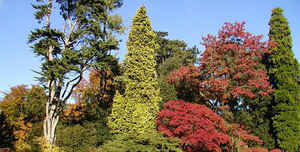
Oklahoma Symbols
Oklahoma State Tree
Eastern Redbud
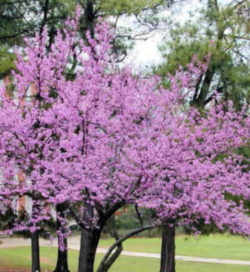
(Fabaceae Cercis canadensis)
Adopted in 1937; June 24, 1971
The Eastern Redbud, (Fabaceae Cercis canadensis,) was adopted in 1937 by Senate Bill 143 as the Oklahoma state tree. The Eastern Redbud, native to North America, grows in the valleys and ravines of Oklahoma. In early spring, its reddish-pink blossoms brighten the landscape throughout the state. Genus name comes from the Greek word kerkis in reference to the resemblance of seed pods to a weaver's shuttle.
Oklahoma State Tree: Eastern Redbud
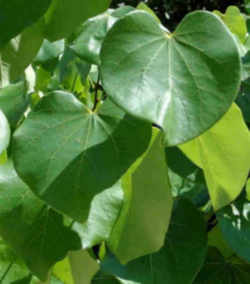
Eastern redbud is a small, short-lived deciduous tree found throughout the eastern United States. Redbud is also known as Judas-tree. According to legend, Judas Iscariot hanged himself from a branch of the European species (Cercis siliquastrum.) Eastern redbud is a strikingly conspicuous tree in the spring because it flowers before other tree leaves form. The wood is heavy, hard, and close-grained, but because of the small size and irregular shape of the tree it is of no commercial value as a source of lumber. This tree is most valued as an ornamental and is extensively planted.
Identification of the Eastern Redbud
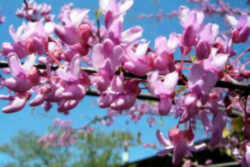
The state tree of Oklahoma, Eastern Redbud is a moderate to rapid-grower when young, reaching a height of 20 to 30 feet. Thirty-year-old specimens are rare but they can reach 35 feet in height forming a rounded vase. Trees of this size are often found on moist sites. The splendid purple-pink flowers appear all over the tree in spring, just before the leaves emerge. Eastern Redbud has an irregular growth habit when young but forms a graceful flattopped vase-shape as it gets older. The tree usually branches low on the trunk, and if left intact forms a graceful multitrunked habit. Yellow (although somewhat variable and unreliable) fall color and tolerance to partial shade make this a suitable, attractive tree for understory or specimen planting.
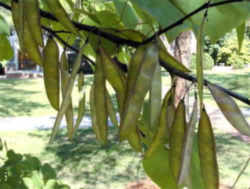
- Leaf: Alternate, simple, cordate in shape with an entire margin, 3 to 5 inches long and wide. The leaves are thin and papery, and may be slightly hairy below.
- Flower: Very showy, light to dark pink in color, 1/2 inch long, appearing in clusters in March to May, before the leaves.
- Fruit: Fruits are flattened, dry, brown, pea-like pods, 2 to 4 inches long that contain flat, elliptical, brown seeds 1/4 inch long. Maturing in July to August.
- Twig: Slender and zigzag, nearly black in color, spotted with lighter lenticels. Winter buds are tiny, rounded and dark red to chestnut in color.
- Bark: Smooth, later scaly with ridges somewhat apparent. Dark in color. May have some maroon patches evident.
- Form: A large shrub or small tree with a short, often twisted trunk and spreading branches.
Oklahoma Senate Bill 143
Senate Bill No. 143
An Act relating to forestry; ... providing state tree; ... and declaring an emergency.
Be it enacted by the People of the State of Oklahoma:
...
SECTION 313. State tree - Redbud
The redbud shall be adopted and the same be made the official tree of this state.
Approved June 24, 1971. Emergency.
[Codified in the Oklahoma Statutes in Title 2, Section 1301-313, which is in Article III, General Forestry Laws, of the Oklahoma Forestry Code, Chapter
28 of Title 2.]
Taxonomic Hierarchy: Redbud
Kingdom: Plantae - Plants
Subkingdom: Tracheobionta - Vascular plants
Superdivision: Spermatophyta - Seed plants
Division: Magnoliophyta - Flowering plants
Class: Magnoliopsida - Dicotyledons
Subclass: Rosidae
Order: Fabales
Family: Fabaceae ⁄ Leguminosae - Pea family
Genus: Cercis L. - redbud
Species: Cercis canadensis L. - eastern redbud






